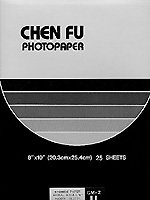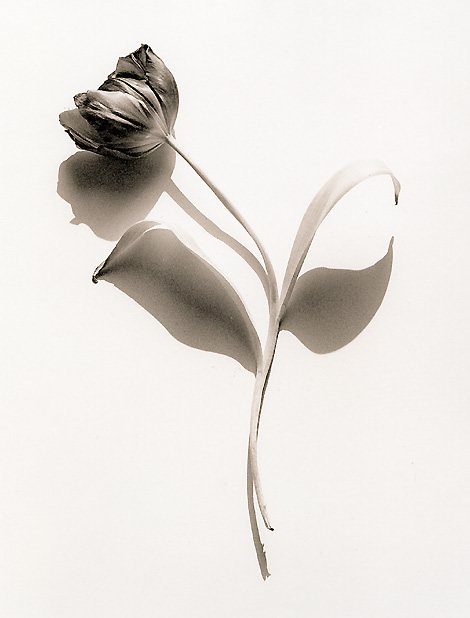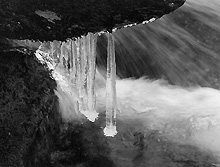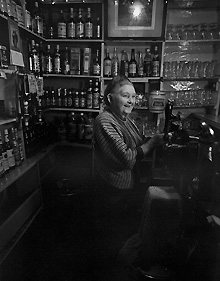
Chen Fu grade b/w photo papers

For the past two to three years most manufacturers have followed the policy
of discontinuing graded papers in preference for variable contrast paper.
During the time that I have written this column I have occasionally lamented
the demise of some of my favourite graded papers and as if to rub salt into
that wound, just last week I was asked by a friend to make some prints from
his negatives. His original prints were made on Agfa Record Rapid and try
as I might I could not match the print colour with variable contrast paper,
so I finally resorted to raiding the dwindling stock of my precious old
graded paper. I had to work a little harder to control the contrast but
the prints were produced and the colour was a perfect match when they dried
and were viewed in daylight the following day.
Now E & S Caswell have imported into Britain from China a range of
graded black and white paper manufactured by Chen-Fu Photo Products.
There are three fibre and four RC papers in the range and they vary from
medium weight cold toned to double weight warm toned. There are four surfaces
glossy, fine grain, semi-matt and silk and all are available in grades 1
to 4. Sizes range from 5 x 7" to 12 x 16" but larger sizes and
rolls will be available in the near future. Not having printed on graded
paper for two years I approached the path to the little darkened room, this
time with a little more spring in the step and in anticipation of renewing
acquaintance with a long lost friend, the graded photographic paper.
THE TESTS
I chose three of the range to test: GM grade 2 Glossy double weight fibre,
KD grade 3 stipple double weight fibre and VRM grade 2 Velvet Matt double
weight RC. All prints were made using the Zone VI Cold Cathode Enlarger
and processed in a single bath developer and my usual stop and fixing baths.
Fibre prints were developed for 3 minutes and RC for 1.5 minutes. Using
an Encapsulite A10 safelight I exposed all papers for 10 minutes after pre-flashing
and found no trace of safelight fog. All papers handled well when both wet
and dry and I would say are slightly heavier than most double weight papers.
GM G2 FB

GM G2 Fibre developed in Lith dev - a beautiful tone results
GM grade 2 fibre is about equal to grade 2 Ilford Multigrade and produces
a slightly warm black. However, when toned
in selenium the paper does cool slightly but benefits from the characteristic
increase in contrast that toning gives. The selenium was diluted at 1 to
6 so the colour change and increased contrast did occur quite quickly. Gold
toning gives a delicate blue colour without the increase in contrast
with the change again taking place quite quickly. The tonal range of Chen
Fu GM grade 2 is smooth with a full range being produced from a fairly high
contrast negative. The glossy unglazed surface is almost eggshell, not unlike
the Record Rapid of old and gives very little flare when viewed in bright
light. When dried face down on a drying rack GM was as flat as most other
fibre papers but still required a minute in a dry mount press at medium
heat to completely flatten it. I found it necessary to reduce the exposure
by 11% when making the final print to compensate for drydown.
KD G3 FB

KD grade 3 fibre has a fine stipple surface similar to Agfa's new Fine Grained
Matt although not quite so smooth. I felt that the grade 3 was about half
a grade softer than most modern papers and certainly considerably softer
than I remember the old graded papers. The print colour is warmer than GM
and it tones well in selenium. The drying characteristics are the same as
GM. The tonal range is good although the blacks are not so rich as those
produced by the glossy GM grade 2 which is to be expected when comparing
textured and glossy surfaces. The drydown factor was 11% which is the same
as GM.
VRM G2 RC

Although you can't tell very easily, the VRM eggshell finish was very
difficult to scan - almost copy-proof
VRM grade 2 is a very heavy, almost triple-weight RC paper and the velvet
matt surface is again similar to an eggshell finish. The print colour is
warm and the contrast similar to its GM grade 2 stablemate. Toning in selenium
does cool down the print colour and increase the contrast. The tonal range
is good and comparable with Ilford Multigrade IV although not so good as
the two fibre papers also tested.
CONCLUSION
These Chen Fu papers have been interesting to work with. The prints that
I produced are comparable in tonal range and quality with any that I have
made using modern variable contrast paper. Yes, I may have had to work a
little harder and employ one or two old dodges to put the image on to the
paper, but I do feel that the end result was worth the effort. One big bonus
was the discovery that all of the papers tested respond to being processed
in lith developer and produce the warm peachy tones
(this second example on VRM RC paper) that are a feature of lith papers
and infectious development.
I also understand that they can be used for the old bromoil process which
requires paper that is not super coated. I intend to investigate this for
a future article as the number of papers available for the bromoil process
is most certainly limited.
To say that I enjoyed again making prints on graded paper would be an understatement.
Making a print that glows is always a challenge that I have met with a determination
bordering on obsession. Since the manufacturers have got their act together
and produced some fine variable contrast papers, which give the printer
a whole new range of benefits, traditional graded papers are gradually disappearing
from the market place. If that were to happen then serious printers would
loose a material that can, in certain circumstances, give an end result
that modern papers cannot match, consider the experience that I mentioned
at the beginning of this test report.
Return to Photon Contents May 96




